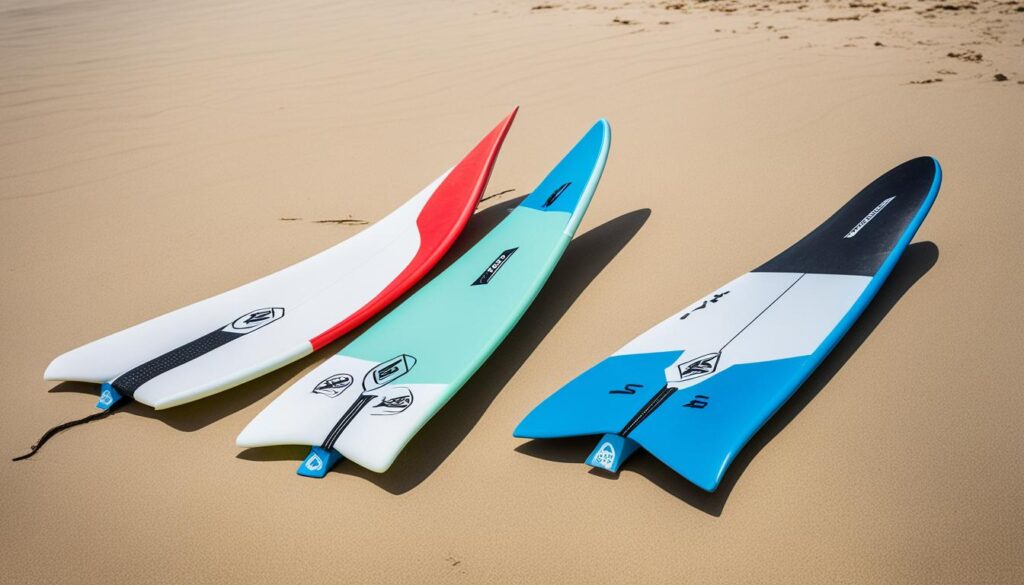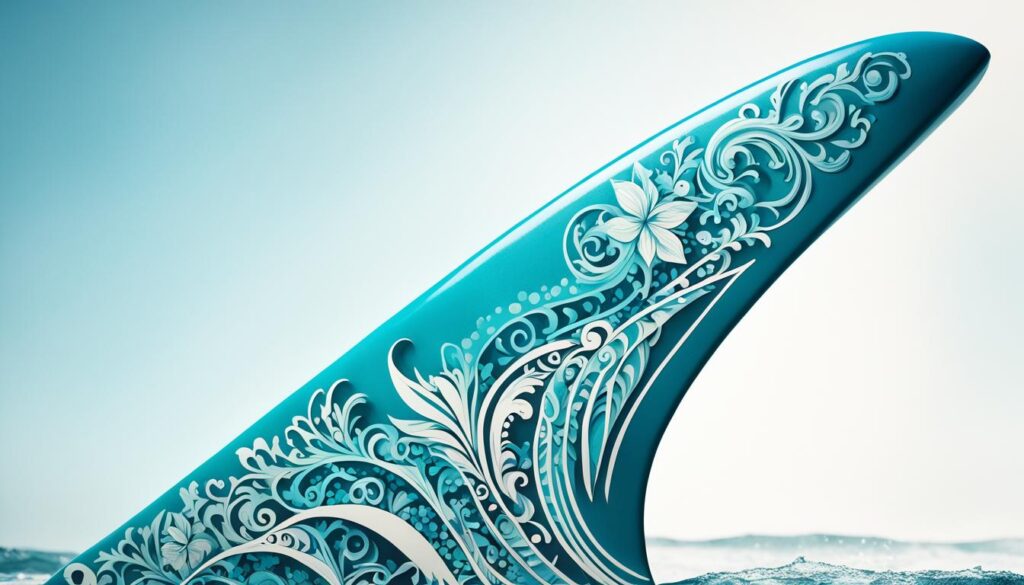When it comes to surfing, every detail matters. From the design of your board to the shape of your fins, each component plays a crucial role in your performance on the waves. But with so many surfboard fin options available, how do you know which ones are right for you?
Choosing the right surfboard fins is essential for maximizing your speed, stability, and maneuverability. Different fins suit different riding styles, surf conditions, and board types. Understanding the various surfboard fin types and configurations can help you make an informed decision and enhance your overall surfing experience.
In this comprehensive surfboard fin guide, we will explore the different surfboard fin options, their characteristics, and how to choose the perfect fins for your style. Let’s dive in and discover the world of surfboard fins!
Key Takeaways:
- Choosing the right surfboard fins is crucial for optimal performance in the water.
- Surfboard fins come in various types, including glassed-in and removable fins.
- Understanding the different fin configurations and boxes can help you tailor your board to your preferences.
- The right fin size depends on your body weight and the number of fin boxes on your board.
- Factors like fin measurements, geometry, and shape also influence a fin’s performance.
Understanding Fin Configurations and Boxes
When it comes to surfboards, the right fin configuration can make a world of difference in your ride. Different surfboard fin setups offer various advantages and cater to specific surfing styles and conditions. Additionally, understanding and choosing the appropriate fin box is crucial for secure fin attachment.
Surfboard Fin Configurations
Surfboard fin configurations refer to the number and placement of fins on a surfboard. Here are the most common fin setups:
- Single fins: Single fins are the traditional fin configuration and are commonly used on longboards. They offer stability and control, making them ideal for classic longboarding styles.
- Twin fins: Twin fins feature two smaller fins mounted on the sides of the surfboard. This configuration provides a playful and maneuverable feel, allowing for smooth and tight turns.
- Thruster fins: Thruster fins are the most popular surfboard fin configuration. With three fins, a larger center fin and two smaller side fins, they offer a balance of stability, control, and maneuverability, making them versatile for various wave conditions.
- Quad fins: Quad fins consist of four fins, with two on each side. This configuration provides speed, good maneuverability, and enhanced stability, making it well-suited for smaller surf.
- 5-fin setups: A 5-fin setup offers the ultimate versatility. It includes five fin boxes, allowing for mixing and matching fins depending on personal preference and wave conditions. You can use it as a thruster, twin, or quad setup, providing adaptability for different surfing styles.
Each fin configuration offers a unique surfing experience, so it’s worth experimenting with different setups to find the one that suits your style and preferences.
Fin Boxes: Glassed-in and Removable Fins
Fin boxes are the slots or holes on the bottom of a surfboard where the fins are secured. There are two main types of fin boxes:
- Glassed-in fins: Glassed-in fins are permanently laminated into the surfboard during the manufacturing process. While they provide excellent stability and control, they are difficult to repair or replace if damaged.
- Removable fins: Removable fins are popular for their versatility and ease of use. Most surfboards today feature removable fins, which can be easily added, removed, or swapped out using a fin key. This allows surfers to experiment with different fin setups and adapt to various wave conditions.
When it comes to fin boxes, two widely used systems dominate the market:
- FCS fin box: The FCS (Fusion Control System) fin box is a dual-tab system that offers secure and quick fin installation. It allows for precise adjustment and fine-tuning of fin placement to customize the board’s performance.
- Futures Fins fin box: The Futures Fins fin box is a single-tab system known for its strength and durability. It provides a solid connection between the fin and the board, ensuring reliable performance.
Now that you have a better understanding of surfboard fin configurations and boxes, you can make a more informed decision when choosing the right setup for your surfing adventures.
Determining the Right Fin Size
When it comes to choosing surfboard fins, finding the right size is crucial for optimal performance. The size of your fins depends on two key factors: your body weight and the number of fin boxes on your surfboard.
Using a fin size chart based on your weight range is a helpful starting point in determining the appropriate fin size. These charts provide recommended fin sizes based on weight categories, ensuring that you select fins that are suitable for your body size and surfing style. Here’s an example of a fin size chart:
| Weight Range | Fin Size (S) | Fin Size (M) | Fin Size (L) |
|---|---|---|---|
| 100 – 150 lbs | Small (S) | Medium (M) | – |
| 150 – 200 lbs | Small (S) | Medium (M) | Large (L) |
| 200+ lbs | – | Medium (M) | Large (L) |
Alongside considering your weight, it’s important to think about the type of board you’ll be riding and the specific waves you’ll be tackling with that setup. Fin size affects your board’s stability, speed, and maneuverability, so understanding how different sizes impact your ride is essential in making the right choice.
Remember, choosing the right surfboard fin size is an individual decision that varies depending on factors such as body weight, board type, and wave conditions. Don’t be afraid to consult with experienced surfers or reach out to professionals at local surf shops for personalized recommendations.
Additional Tips for Choosing the Right Fin Size:
- Experiment with different fin sizes to find the perfect fit for your surfing style.
- Consider the conditions you typically surf in—smaller fins are ideal for smaller waves, while larger fins provide more stability in bigger, more powerful surf.
- Take into account your skill level and surfing goals. Beginner surfers may benefit from larger fins for increased stability, while advanced surfers may prefer smaller fins for increased maneuverability.
- Regularly reassess your fin size as your skills and fitness level progress, as your ideal fin size may change over time.
Remember, the right fin size can greatly enhance your surfing experience, so take the time to choose the fins that best suit your needs. Happy surfing!
Exploring Different Fin Configurations
Different fin configurations offer unique riding experiences, allowing surfers to tailor their boards for specific conditions and styles. Whether you prefer stability, speed, maneuverability, or versatility, there is a fin configuration to suit your needs. Let’s take a closer look at some popular fin configurations:
Single Fin
Single fin setups are commonly found on longboards and are known for providing excellent stability and control. The single fin design offers a balanced and smooth ride, making it ideal for cruising and nose riding.
Twin Fins
If you’re looking for a fun and playful surfing experience, twin fins are a great option. With two fins attached to the board, twin fins offer a skatier feel and the ability to perform longer, drawn-out turns. This configuration enhances the board’s speed and maneuverability.
Thruster Fins
The thruster fin setup, featuring three fins, is the most common configuration in modern surfboards. The combination of one large center fin and two smaller side fins provides surfers with stability, control, and excellent maneuverability. The thruster fin configuration is versatile and well-suited for various wave conditions.
Quad Fins
Quad fins utilize four fins and are known for their speed and stability, making them particularly effective in smaller surf. The two extra fins on the board’s corners provide additional control and drive. Quad fins excel in generating speed and offer a unique surfing experience.
5-Fin System
For ultimate versatility, the 5-fin system allows surfers to switch between different fin configurations. Whether you want the speed of a twin fin, the control of a thruster, or the stability of a quad, the 5-fin system gives you the freedom to adapt to changing wave conditions and experiment with different riding styles.
By understanding the characteristics of each fin configuration, you can choose the setup that best aligns with your surfing goals and preferences. Now that you have an overview of the different options available, you can select the perfect fin configuration to enhance your surfing experience.
Understanding Fin Measurements and Geometry
Fins play a crucial role in the performance of a surfboard, and understanding their measurements and geometry is key to finding the perfect match for your surfing style. Let’s explore the various aspects that contribute to the overall performance of surfboard fins.
Fin Sweep (Rake)
Fin sweep, also known as rake, refers to the curvature of the front edge of a fin. It determines how far the fin arcs backward from its base. Fins with more sweep offer increased control, stability, and hold in larger waves. On the other hand, fins with less sweep provide quicker turns and maneuverability in smaller waves.
Fin Toe (Splay)
Fin toe, or splay, describes the angle of the side fins in relation to the board’s stringer. It greatly influences the board’s ability to initiate and hold turns. Fins with more toe angle can generate more powerful and drawn-out turns, while fins with less toe angle are better suited for quick and snappy maneuvers.
Fin Base Length
The fin base length refers to the distance between the leading edge and the trailing edge of the fin at its widest point. It affects the board’s response to turns and generates stability. Longer fin bases provide increased hold and control, making them ideal for larger waves and powerful surf. Conversely, shorter fin bases allow for quicker and more responsive turns, which are favored in smaller and weaker surf.
Fin Foil
Fin foil refers to the shape of the fin’s outside and inside faces. It plays a significant role in controlling the flow of water over the fin, thereby influencing its performance. A fin with a symmetric foil provides balanced performance, while a fin with an asymmetric foil can enhance specific characteristics such as speed, lift, or maneuverability.
Fin Flex
Fin flex pertains to the stiffness or flexibility of a fin. Stiff fins offer stability and are better suited for powerful surfers or larger waves, as they provide control and drive. Conversely, flexible fins allow for easier initiation of turns and sharper maneuvers, making them ideal for surfers who prefer a more responsive and lively feel.
Fin Height
The fin height refers to the distance between the base of the fin and its highest point. It influences a board’s stability and grip through turns. Taller fins provide increased hold and stability, making them suitable for larger waves. Shorter fins, on the other hand, offer quicker transitions between turns and increased maneuverability, which are beneficial in smaller and more playful surf.
Fin Cant
Fin cant, also known as fin angle, defines the inclination of the top of the fins in relation to the board. It affects the fluidity of turns and the overall feel of the board. Fins with more cant angle deliver more pivot and tighter turns, while fins with less cant angle offer smoother and more drawn-out turns.
Understanding the measurements and geometry of surfboard fins empowers surfers to fine-tune their equipment for optimal performance in various wave conditions. By selecting fins with the right combination of sweep, toe, base length, foil, flex, height, and cant, surfers can enhance their style and maximize their enjoyment in the water.

| Fin Measurement | Explanation |
|---|---|
| Fin Sweep (Rake) | Curvature of the front edge of a fin |
| Fin Toe (Splay) | Angle of the side fins in relation to the board’s stringer |
| Fin Base Length | Distance between the leading edge and the trailing edge of the fin at its widest point |
| Fin Foil | Shape of the fin’s outside and inside faces |
| Fin Flex | Stiffness or flexibility of a fin |
| Fin Height | Distance between the base of the fin and its highest point |
| Fin Cant | Inclination of the top of the fins in relation to the board |
Choosing the Right Fin Shape
When it comes to surfboard fins, the shape plays a crucial role in determining the performance characteristics of your board. Each fin shape offers its own unique benefits, allowing you to optimize your surfing experience. Here are the main fin shapes to consider:
Single Fin
The single fin setup is classic and versatile, offering stability and control. This configuration is commonly found on longboards and provides excellent glide and trimming capabilities. The single fin is ideal for smooth, flowing turns and works well in small to medium-sized waves.
Twin Fin
If you’re looking for a more playful and maneuverable ride, the twin fin configuration is worth considering. Twin fins provide speed and stability, allowing for quick turns and smooth carving. This setup is known for its skate-like feel and responsiveness. It works particularly well in small to medium-sized waves and is a favorite among surfers who value speed and flow.
Thruster Fin
The thruster fin setup is the most common configuration used by surfers of all levels. It consists of three fins: a larger center fin and two smaller side fins. This setup offers a balance of stability, control, and maneuverability. The thruster fins excel in a wide range of conditions, allowing surfers to perform powerful turns and carve with precision. It is the go-to setup for most surfboard designs and wave conditions.
Quad Fin
For those seeking speed and hold, the quad fin configuration is a great option. This setup consists of four fins, with the two larger fins in the front and two smaller fins in the back. Quad fins provide exceptional speed and stability, making them ideal for down-the-line surfing and generating speed in smaller waves. They also offer good hold and control in larger, more powerful waves.
5-Fin System
The 5-fin system, also known as a thruster-quad setup, offers ultimate versatility. This setup allows you to mix and match fins, enabling you to adapt to different wave conditions and fine-tune your board’s performance. With the ability to switch between twin, thruster, and quad configurations, the 5-fin system provides the best of both worlds, giving you the freedom to experiment and customize your setup.
Choosing the right fin shape is essential in maximizing your surfboard’s potential. Consider your skill level, wave conditions, and desired riding style when selecting a fin configuration. Whether you prefer stability, speed, control, or versatility, there’s a fin shape that’s perfect for you and your surfboard.
How to Size and Install Your Surfboard Fins
Properly sizing your surfboard fins is essential for achieving optimal performance in the water. To determine the right size for your fins, consult a fin size chart based on your weight range. Keep in mind that the type of board and the waves you’ll be riding also play a role in selecting the appropriate size.
Once you have the right fins, it’s time to install them on your surfboard. The installation process depends on the type of fin box your board has. If you have FCS fins, you’ll need screws to secure them in place. On the other hand, if you have Futures Fins, you’ll use grub screws for installation.
Remember that proper installation and maintenance of your surfboard fin boxes are crucial for ensuring their longevity and functionality. Take care to follow the manufacturer’s instructions and regularly inspect your fin boxes for any signs of wear or damage.
By correctly sizing and installing your surfboard fins, you’ll be able to optimize your performance in the water and have an enjoyable surfing experience.

